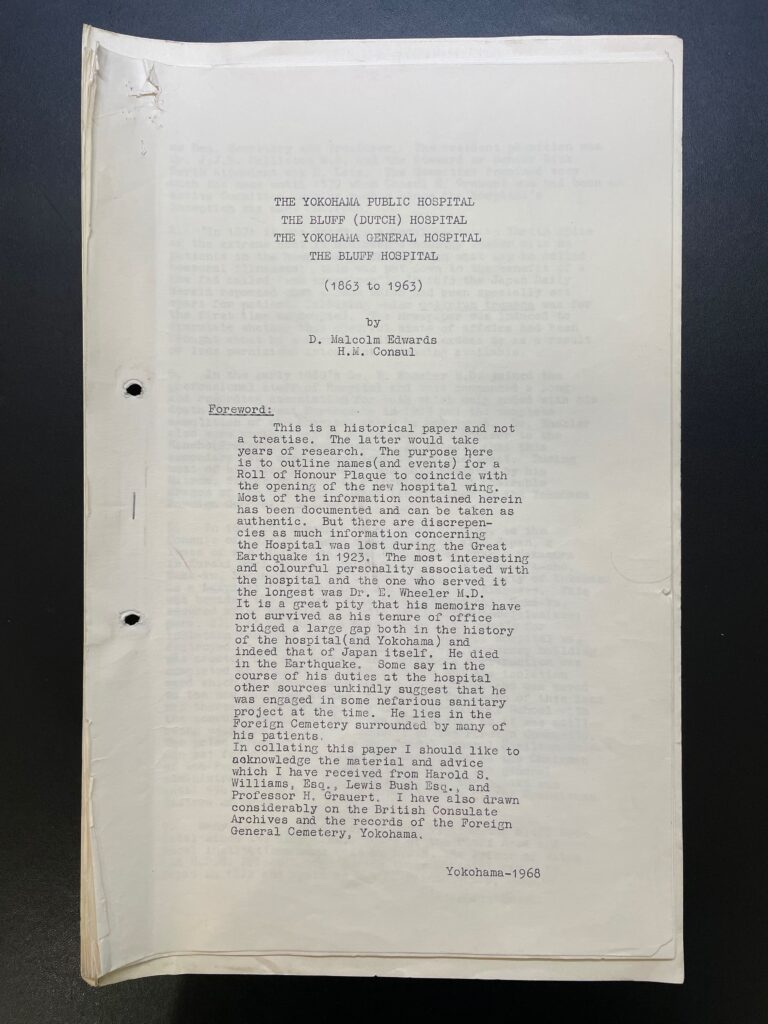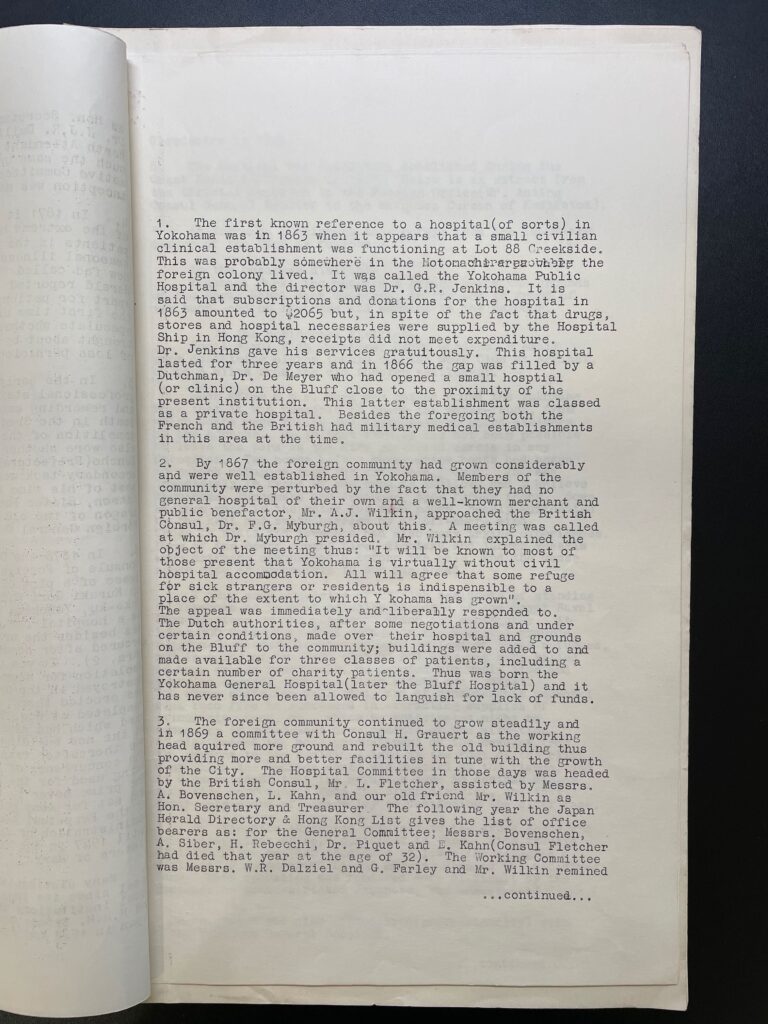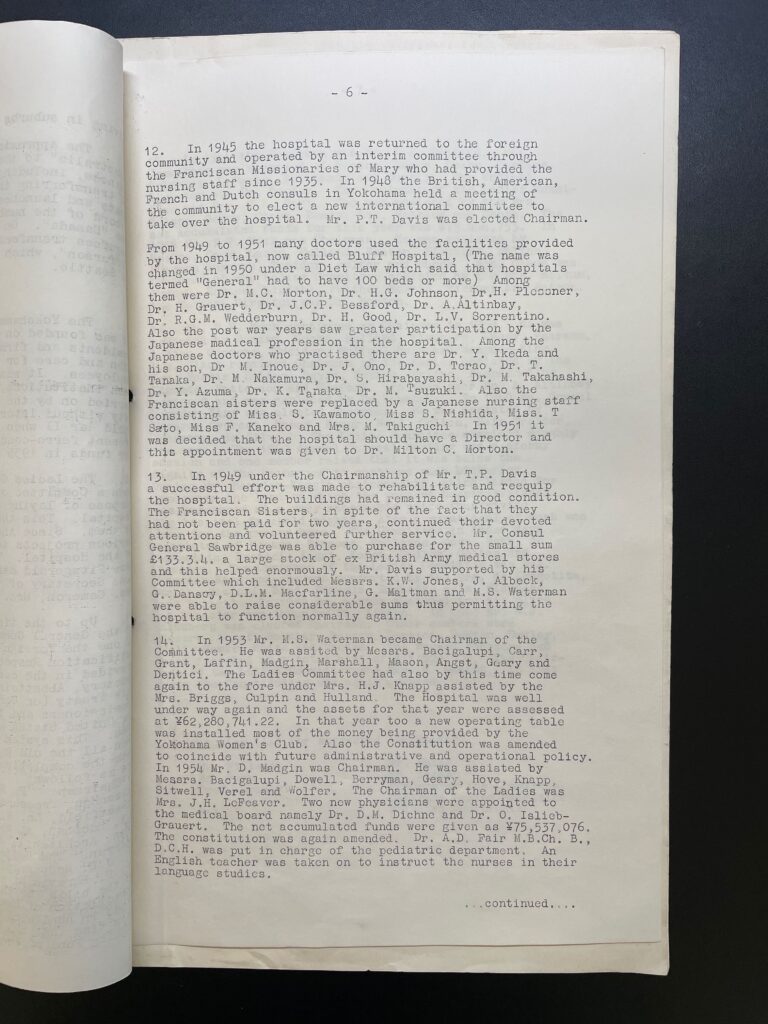History of the Bluff Clinic
Contents (last update, December 2024):
- Bridging Cultures with Medical Care Since 1863
- The Legacy of the Bluff Clinic
- Summary of Events in the History of the Bluff Clinic
- Timeline from the Yokohama Public Hospital to the Bluff Clinic
- Foreign Naval Hospitals in Yokohama: From Establishment to Withdrawal
- The Introduction of Western Medicine in Japan and the Origins of Universities
- Hospitals Established in Yokohama (1863~)
- The Great Kanto Earthquake (1923)
- During and after the Second World War
- Closure of the Bluff Hospital and Opening of the Bluff Clinic
Bridging Cultures with Medical Care Since 1863
The Bluff Medical and Dental Clinic traces its origins to a hospital established in 1863 at the Foreign Settlement in Yokohama. Subsequently, the hospital relocated to the Bluff, where it now stands at 82 Yamatecho. This history ties the Bluff Clinic closely to Yokohama’s legacy as a gateway to the internationalization of Japan.
The clinic’s objective is to engage in medical activities that enhance the well-being of local residents and contribute to the betterment of the community including public benefit activities.
Our organization is officially registered as 一般財団法人ザ・ブラフ・クリニック (Ippan Zaidan Hojin The Bluff Clinic), expressed in English as “The Bluff Clinic Foundation” (hereinafter referred to as “The Bluff Clinic”). Operating from 82 Yamatecho, the Bluff Clinic continues its mission of delivering high-quality medical care to both foreign and Japanese residents.
A unique aspect of our mission is providing bilingual services in English and Japanese, ensuring accessible healthcare for a diverse community. With a welcoming, fully English-speaking environment, the Bluff Clinic serves as an ideal entry point into the Japanese medical system for many foreign residents.

The Legacy of the Bluff Clinic
The Bluff Clinic is arguably the longest-operating medical institution specializing in Western medicine in Japan that has been operating at the same location, having been situated at Yamatecho 82 on the Bluff since June 10, 1866.
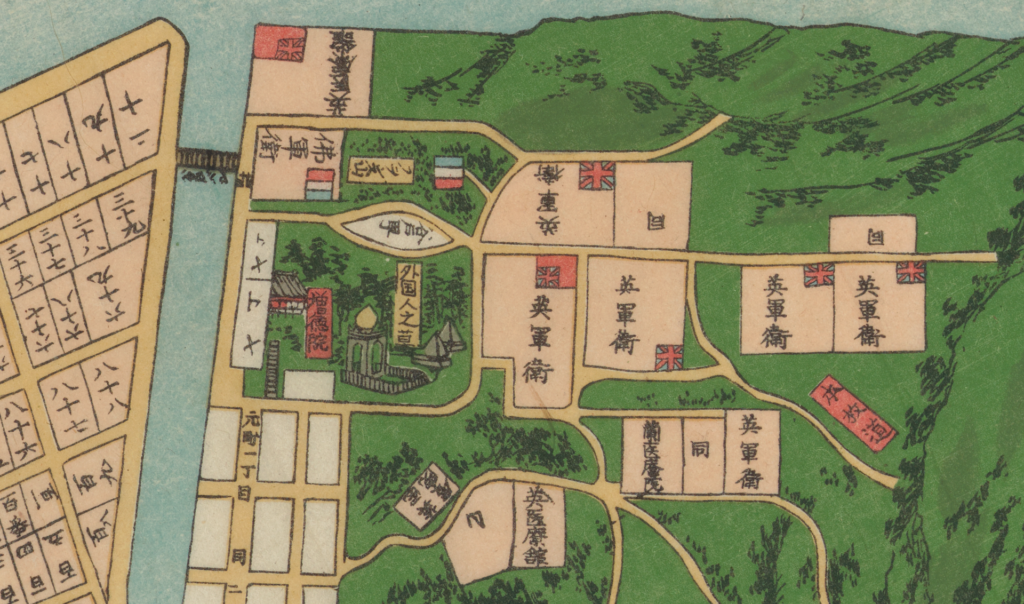
Its history dates back even further to April 1863, with the establishment of the Yokohama Public Hospital, located down the hill at Yamashitacho 88.
Summary of Events in the History of the Bluff Clinic
- The Yokohama Public Hospital was founded in 1863 in Yamashitacho but fell into decline by 1866. In 1867-1868, it merged with the Dutch Naval Hospital, which had been established in 1866 at the current Yamatecho 82 location. This merger created the Yokohama General Hospital.
- The 1923 Great Kanto Earthquake destroyed the Yokohama General Hospital, necessitating its relocation approximately 2 km west to the infectious diseases ward, where it remained until around 1936.
- In 1942, the Yokohama General Hospital was designated an enemy asset during the Second World War and was used by the Japanese Yokosuka Navy from 1944 to 1945. The hospital was retaken by the U.S. military in 1945 and subsequently reopened.
- In 1950, the hospital was renamed Bluff Hospital. It closed in 1981 due to financial difficulties and in 1986 reopened as the Bluff Clinic at the same location.
- In 2005, a dental department was added, and the clinic was renamed the Bluff Medical and Dental Clinic.
Timeline from the Yokohama Public Hospital to the Bluff Clinic
Yamashitacho 88
April 1863 – January 4, 1867: The Public Hospital (Y.P.H.)
Yamatecho 82
June 10, 1866 – January 6, 1868: The Dutch (Naval) Hospital (オランダ海軍病院, “Oranda Kaigun Byoin”)
January 6, 1868 – 1949: Yokohama General Hospital (一般病院, “Yokohama Ippan Byoin”)
- November 26, 1868: Partially destroyed by fire; rebuilt and expanded in 1869.
- September 1, 1923: Destroyed by the Great Kanto Earthquake; temporarily relocated to the infectious diseases ward at Karasawa 41 until about 1936.
- 1935 – 1936: Hospital rebuilt at Yamatecho 82.
- June 5, 1942: Designated as an enemy asset and transferred to the Yokohama General Hospital Foundation on January 20, 1944.
- March 1944: Foreigners banned from Yamatecho; Yokosuka Naval Hospital used the facility until August 30, 1945.
- July 1, 1944: Operations partially transferred to a new location on Aioicho Street in Kannai.
- May 29, 1945: Both Yamatecho and Kannai locations survived the bombing of Yokohama.
- August 30, 1945: Yamatecho hospital taken over by the U.S. military.
1950 – October 1, 1981: Bluff Hospital (山手病院, “Yokohama Yamate Byoin”)
- 1950: Renamed Bluff Hospital.
- 1968: Building underwent large expansion.
- October 1, 1981: Operations ceased; building was demolished in 1982.
October 1, 1981 – March 20, 1986: No Operations
March 21, 1986 – Present: Bluff Medical and Dental Clinic (The Bluff Clinic Foundation)
Foreign Naval Hospitals in Yokohama: From Establishment to Withdrawal
Already withdrawn from Yokohama before the 1923 earthquake:
1864 – 1873: The French (Military) Hospital (“L’Hôpital Militaire Jaurès“)
- A medical school where Japanese students learned from doctors of the French Navy. (link) A picture is here. Its location was on the Bund (current New Grand Hotel Tower) near the French Hatoba in Yamashitacho, with visible pillars in the water.
1878 – 1911: The German Navy Hospital (“Lazarett der Deutschen Kaiserlichen Marine“)
- Planning started in 1869. Construction started on January 1, 1877, and the opening was on on July 1, 1878. The hospital was used less after another hospital was opened in China in 1898, and is was closed on December 31, 1911 and become a German school.
- Initially, the site for the construction of the hospital was Yamatecho 152-153, but in October 1873 a larger plot of land was requested and the hospital was built at Yamatecho 40-41 (current Motomachi Elementary School). (link)(link)(link)
Destroyed during the 1923 earthquake, and subsequently withdrawn:
1874 – 1923: The Royal Navy (English) Sick Quarters
- Located at Yamatecho 115 (current British House). A picture is here.
1881 – 1923: The United States Naval Hospital
- Located at Yamatecho 99 (current Meteorological Observatory).
- A new U.S. Naval Hospital was later established in Yokosuka after World War II. (link)
Destroyed in the 1923 earthquake, but later rebuilt:
1866 – present: The Dutch Navy Hospital (“Nederlandse Marinehospitaal“)
- Located at Yamatecho 82. It merged with the Yokohama Public Hospital in 1868 to become the Yokohama General Hospital (the predecessor of the Bluff Clinic).
The Introduction of Western Medicine in Japan and the Origins of Universities
With the establishment of Dutch trading posts in Kyushu, first in Hirado (1609-1641) and then in Nagasaki (1641-1843), the Dutch introduced books on Western medicine, which were gradually translated into Japanese. The influx of Dutch books and their Japanese translations increased after 1720, when restrictions were relaxed by the Shogunate. From 1804 to 1829, schools began opening throughout Japan to disseminate these new ideas. In 1824, German physician Philipp Franz von Siebold, attached to the Dutch delegation in Nagasaki, began exchanges with Japanese students. He established a medical school on the outskirts of Nagasaki called Narutaki-juku, where about fifty students from across Japan received medical training.
Osaka University
Continue reading about Osaka University by clicking here.
Ogata Koan, who studied in Nagasaki from 1836 to 1838, opened a Western-style medical school called Tekijuku in Osaka in 1838. He published Japan’s first book on pathology in 1849. Education and medical practices at Tekijuku continued until around 1886. The Tekijuku building is the only remaining pre-Meiji school for Western learning still in existence. Koan’s son and others later established Osaka Medical School (Osaka Igakkou) in 1870, inviting Dutch doctor Christiaan Jacob Ermerins to join the faculty. This school and hospital underwent numerous transitions, eventually evolving into the School of Medicine of Osaka Imperial University, and ultimately into today’s Osaka University.
Nagasaki University
Continue reading about Nagasaki University by clicking here.
On November 12, 1857, Dutch naval surgeon Johannes L.C. Pompe van Meerdervoort, a “Health Officer 2nd Class of the Royal Dutch Navy,” initiated medical lectures in the Dutch language in Nagasaki for about 12 students. (link) In 1860, Nagasaki Koshima Yojosho was established as Japan’s first modern Western-style hospital, where van Meerdervoort provided medical care. (link) A picture of the Yojosho hospital from 1871 can be found here. This hospital is a predecessor to the Nagasaki University School of Medicine. The last parts of the building were demolished in 1889.
Tokyo University
Continue reading about Tokyo University by clicking here
In May 1858, a vaccination center was opened in Tokyo by practitioners trained in Dutch medicine. In October 1860, the Tokyo vaccination center became an official medical institution of the Shogunate Government. The institution was relocated to its current site in 1876 and eventually transformed into Tokyo University. (link)
The Origins of Modern Yokohama and the Introduction of Western Medicine
1854
- Following his first visit to Yokohama in 1832, U.S. Commodore Matthew Perry returned to sign the Treaty of Kanagawa with the Edo Shogunate on March 31, 1854, in Yokohama Village. This treaty established peace and amity between Japan and the United States, although only the ports of Shimoda and Hakodate were opened at that time. Yokohama Village was then a small fishing and farming community. (link)
1859
- July 1: The Port of Yokohama opened to foreign trade following the 1858 treaty signed by American consul Townsend Harris, allowing more ports to open.
- October 24: Initially, foreign residents in Yokohama relied on private practitioners. The first clinic, “Kanagawa Hospital,” was opened by British doctor Richard W. Duggan on October 24, 1859, though little is known about its later history. (link) Duggan, an Irishman from Galway, was noted for his questionable character. (link)
1860
- June: American George Martin Bates opened a medical practice in Yokohama but left Japan by the end of 1861.
- October: American Duane B. Simmons also established a medical practice.
1861
- By 1861, maps showed Yokohama as a growing foreign settlement with consulates, trading houses, and churches. Although private clinics existed, there was still no hospital for inpatient care. Prussian consul Maximilian August Scipio von Brandt advocated for a hospital. (link)
- Dr. James Curtis Hepburn, an American physician and missionary, relocated from Nagasaki to Yokohama in October 1859 and opened his first clinic in April 1861 at Sokoji Temple in Kanagawa. (link)
1862
- Dr. Hepburn’s Kanagawa clinic closed after authorities discouraged patients from visiting it, pressuring him to move to Yokohama. He and his wife later opened the “Hepburn School” at Yamashitacho 39 in winter 1862, where he provided medical services and trained Japanese doctors. This school eventually evolved into Meiji Gakuin University and Ferris University. Hepburn is also known for developing a romanization system for Japanese. He returned to the U.S. in 1892. (link)
- English doctor William Willis arrived in Yokohama to serve the English legation after graduating from the University of Edinburgh. He struggled to procure reliable Western medicines due to limited availability and high costs, with some counterfeit products in circulation. Willis’s situation highlighted the need for government oversight, which came about 15–20 years later. (link)
- September 14: The Namamugi Incident, in which British subjects were attacked by samurai near Yokohama, raised concerns among foreign residents about the lack of a dedicated hospital.
Hospitals Established in Yokohama
1863
- January 7: Chinese residents established the Dosai Hospital for their community, located on lot 135 of the foreign settlement, which is now Yamashitacho Park. (link) (link)
- April: European and American residents desired a public hospital, which materialized in April 1863 when the Yokohama Public Hospital opened on Yamashitacho 88, with 30 beds. The hospital was managed by Griffith Richard Jenkins, a former British legation doctor who continued practicing there after his retirement, along with his successor, William Willis. Willis and Jenkins procured Western medicines through Willis’s brother, who managed a clinic in England. However, a shortage of medicines persisted due to the lengthy transportation time, which often exceeded expectations. The Prussian consul von Brandt chaired the hospital’s management committee.
Initially, the hospital was managed and operated by a committee of foreign residents, supported by a donation of $2,065. Medical supplies and necessary items were provided at government prices from a hospital ship in Hong Kong. The hospital relied on subscriptions to stay afloat, but it was difficult to persuade the community to contribute even in the early days. Eventually, Japanese patients were also treated. Jenkins worked without compensation, yet the hospital struggled financially, ultimately falling into decline by the end of 1866. At that point, it began charging high fees, and no patients were admitted until payment was received. (link) (link)
1864
- A photograph taken in 1864 by the British photographer Felice Beato, “Yokohama from the Bluff” shows the Yokohama Public Hospital building on the far left. (link)

- Willis and Jenkins established the Yokohama Dispensary, a joint investment that imported foreign medicines following the arrival of Portuguese pharmacists in Japan. They received numerous orders from the Legations and the Yokohama Public Hospital, which was managed by Dr. Jenkins. Despite early success, a lack of human resources forced them to close the Yokohama Dispensary in 1867. In 1868, Willis was ordered to go to Kyoto to assist injured soldiers, which earned him the trust of the Satsuma clan. As a result, he was later appointed as a professor at a school in Tokyo, a predecessor of the University of Tokyo’s Faculty of Medicine. (link)
- In a letter sent to his home country on August 26, 1864, Willis mentioned that Jenkins had more patients than he could handle alone. According to Young Japan, written by British journalist John Reddie Black, Jenkins worked without compensation, with medical supplies provided at low cost from a hospital ship in Hong Kong and numerous donations received. Despite these efforts, the income did not meet the expenses. The Japan Herald, on February 13, 1864, published a summary of accounts for the six months from June 1863 to January of the following year, revealing a deficit of $1,200, which had to be covered by borrowing. Although the Yokohama Hospital was expected to address infectious diseases—similar to the smallpox hospital—it was not in a position to meet these expectations. An editorial in the Japan Heraldpointed out that while residents were asked for contributions, the management was monopolized by the consular corps, leaving the local residents with no say in the matter. (link)
- The French hospital was established on the Bund as a medical school, where Japanese students learned from doctors of the French Navy.
- The infectious disease ward was relocated from Hitaizaka (next to the current Motomachi Park) to Nakamuramachi 1299, a 1863 tsubo (6159 m2) location at the current address of Karasawa 41 (link). The 1895 Directory mentions this being at Aizawa. Whether this is another name for the site is a matter for conjecture. Later on in 1878m the Governor of Kanagawa granted to the Consults of Foreign Powers having treaties with Japan, a lease of to the land for use of the foreign community of Yokohama as a hospital for infectious and contagious diseases. This was besides the original site at 82 Yamatecho secured after negotiations with the Dutch Authorities. It was used as as secondary site mostly for isolation for many years and when the General Hospital was destroyed in the Great Earthquake of 1923, when a temporary building was erected there.
1865
- May 1865: Two Dutch naval surgeons, Arend de Meyer and Cornelis Gerardus de Jong, opened a practice at lot 41 of the settlement. They also began working at the Dutch Naval Hospital in 1866. (link)
1866
- June 10: The Dutch Naval Hospital was established at what later became lot 82B in the Yamate settlement, on part of the land previously used as a Dutch Navy coal depot. The hospital had 34 beds. Building on the success of its Western-style medical training in Nagasaki, the Netherlands aimed to expand into Edo (modern Tokyo) and lobbied the Edo Shogunate to establish a medical school and hospital. As a preparatory step, they first opened a naval hospital in Yokohama and assigned former Dutch naval surgeons de Meyer and de Jong to provide care there. However, with the Shogunate in crisis, there was no opportunity to establish a medical school. Financial struggles also plagued the Yamate naval hospital, prompting the Dutch consulate to consider closing it. (link)
- March 20: In a letter from Yokohama, the United States Legation expressed dissatisfaction with the Yokohama Public Hospital, noting that it charged exorbitant fees and would not admit patients until fees were paid. The letter stated:
“While temporarily residing at this place, for the purpose of daily consultation with the representatives of the treaty powers in reference to the negotiations for the revision of the tariff, now in progress, I soon became convinced of the great importance to our interests of establishing an American marine hospital at Yokohama. On inquiry, I found that there exists a so-called general hospital in a small building, wholly unsuited for the purpose, owned by an English physician, into which no patients are admitted except on the payment of exorbitant fees. To this establishment, it became necessary to remove some of our wounded from the Wyoming, after her action at Simonoseki in 1863. The English and French have already established national hospitals at this place; and their sick, both civil and military, receive all the care and attention they require.“ - Toward the end of 1866, the Yokohama Public Hospital encountered financial difficulties. Around this time, a municipal council was formed to promote settlement autonomy, with a sanitation and road committee established under it. At a consular meeting held on November 23, it was decided to delegate the hospital’s operation to the municipal council, but this arrangement does not appear to have succeeded. (link) Some sources even suggest that the hospital closed for a year in 1866. (link)
- November 26: The “Great Fire of Yokohama” destroyed one-fourth of the foreign settlement and one-third of the native town. However, both the Dutch Naval Hospital and the Yokohama Public Hospital were spared. The French hospital on the Bluff barely escaped the flames.
1867
- At a consular meeting on January 4, 1867, it was decided to liquidate the Yokohama Public Hospital and transfer the assets to the two Dutch doctors, Arend de Meyer and Cornelis Gerardus de Jong at the Dutch Naval Hospital. According to an advertisement published by the two doctors in the third issue of the Japan Daily Herald in late March 1867, the Dutch Naval Hospital was reorganized into a “general hospital for all nations,” providing care without distinction of social class or nationality. In this advertisement, the hospital was referred to as the “General Hospital.”
- However, similar to the Yokohama Public Hospital, the Dutch Hospital (or General Hospital) also encountered financial difficulties and was on the verge of closure. In response, in late 1867, a movement arose among foreign residents, led by Alfred John Wilkin (an Englishman residing in Yokohama since 1863), to preserve a public hospital. Mr. Wilkin approached the British Consul, Dr. F. G. Myburgh about this.
1868
- January 3, 1868: The Emperor officially stripped the Tokugawa Shogunate of its powers, marking the start of the Meiji Restoration and a new era (1868–1912) in Japan’s history. Although the Meiji Restoration began, battles continued between the Emperor’s forces and those loyal to the Shogunate until the following year. Trade and interactions with the Western world were increasingly encouraged.
- January 6, 1868: A meeting was called at which Dr. Myburgh presided. The first proposal was to lease the Dutch Hospital along with its doctors and facilities, with the foreign residents covering the Dutch hospital’s expenses. The second proposal was to rebuild the Yokohama Hospital, though this plan was not realized.A proposal to lease the Dutch Hospital was adopted at a meeting attended by consuls and residents, leading to the establishment of the Yokohama General Hospital, commonly known as the Bluff Hospital. The committee had learned from the earlier failure of the Yokohama Public Hospital, where management had been monopolized by the consular corps. The Yokohama General Hospital offered three classes of service, including charity cases, and continued to receive subsidies from the Dutch government.
- The constitution of the Yokohama General Hospital (“Yokohama Ippan Byō-in”) stated: “The Yokohama General Hospital is a non-profit-making institution for the general welfare and benefit of the foreign community of Yokohama.” A full version can be found here (pages 55 – 56).

- A map dated 1868 from Yokohama stored at the Dutch National Archives shows the Dutch Hospital. The original map is here.

- Various public health issues in Yokohama:
- August: The “Yokohama Lock Hospital” was established specifically to treat prostitutes. Between 1863 and 1875, approximately 1,000 British and French servicemen were stationed in Yokohama. During this period, there were 101 brothels and over 1,000 prostitutes in the town, which led to the spread of venereal infections, including syphilis and gonorrhea. The Lock Hospital was created to address this pressing public health issue. This hospital and a number of medically regulated brothels were established at the behest of the British Royal Navy and staffed by a naval surgeon, George Newton. At the end of the hospital’s first year of operation he estimated that inspection had prevented at least 33,497 men from being infected. (link)
- In 1858, a cholera outbreak swept across all the main islands of Japan, resulting in up to 200,000 deaths, with Kanagawa suffering heavily. The outbreak began on an American ship in May and gradually spread to Nagasaki, Hiroshima, and Osaka, eventually reaching the city of Edo by July. While smallpox and measles had long swept through Japan in periodic waves, and diseases such as dysentery, typhus, and typhoid were common, none had caused as much death and suffering in such a short time as this cholera epidemic. Amidst the confusion, Ogata Koan worked to translate foreign medical texts on cholera, attempting to understand the disease. Unfortunately, this epidemic was not the last, and many cholera outbreaks would follow in Japan.(link)
- November 25: Approximately two years after the “Great Fire of Yokohama,” a fire broke out at the Dutch Hospital, caused by an overheated stove. According to The Hong Kong Daily Press on December 14, 1868, the Yokohama General Hospital—located on the Bluff and known as the Dutch Hospital but serving as the General Hospital—was nearly destroyed. Although the fire engine appeared to be out of order, nearby French and English sailors and soldiers quickly arrived to help. Only the kitchen and the third- and fourth-class wards escaped the flames. No fatalities were reported. Fortunately, the building was fully insured and would be restored. The full article is here.
1869
- Herman Ludwich Grauert, a German who arrived in Yokohama with his brother via the Dutch trading post in Nagasaki, established a trading company and served as the Prussian Honorary Consul in Yokohama from 1861 to 1864. In 1862, he contributed to the foreign community by donating money and three plots of land for the construction of Japan’s first Catholic church. As Chairman of the General Hospital, he also initiated plans for the hospital’s first expansion in 1869 after a fire had destroyed most of its buildings. (link)
1870
- Dr. James Joseph Robert Dalliston, born in New Zealand in 1821, specialized in surgery and moved to Yokohama in 1869. He became the head of the “Japan Dispensary” located at Yokohama #108, and in 1870, he took on the role of head of the “Medical Hall and Aerated Water Manufactory” at Yokohama #60. By 1870 or 1871, he was appointed director and resident doctor of the Yokohama General Hospital, a position he held until his death on January 20, 1875, at the age of 52. At that time, the hospital occupied 1,000 tsubos of land (approximately 3,300 m²). (link)
- The Japanese government evaluated several medical systems, including the Dutch, British, French, and American models, before officially adopting the German model of medical education and healthcare in March 1870.
1877
- One cholera outbreak in Yokohama in 1877 is believed to have originated on a British naval vessel; however, the British insistence on freedom of navigation hindered efforts to control the spread of the disease. By 1879, cholera had infected approximately 160,000 people in Japan, resulting in a death toll of around 100,000.
1891
Possibly the oldest remaining picture taken at the Yamatecho 82 site is a picture from the interior of a futuristic house built with iron and glass by Dr. Willem van der Heyden which was built on the hospital grounds. The so called “Sanitary Dwelling” had double glass walls in the form of tanks which contained a saturated solution of alum salts harnessing it eutectic properties to regulate the temperature of the interior. The article is here.

1908
- The 1908 book “The city of Yokohama, past and present“ the “Sanitary Arrangements” in Yokohama in 1906 are described on pages 124 -125:
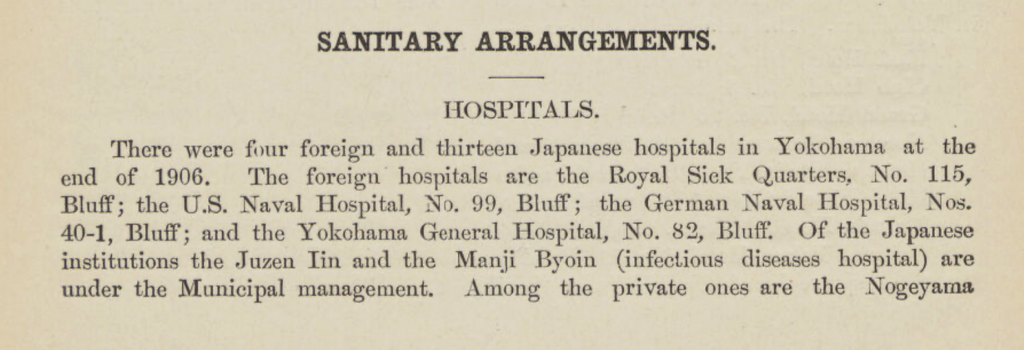

- Page 126 of the same book contains a picture and description of the Yokohama General Hospital. This is probably the oldest remaining picture of the hospital exterior.

Resource
- Persistent Link https://nrs.lib.harvard.edu/urn-3:fhcl:2796273
- Description The city of Yokohama, past and present. Yokohama : The “Yokohama” Publishing Office, 1908.
- Repository Collection Development Department. Widener Library. HCL
- Institution Harvard University
- Accessed 16 August 2024
1915
- An original postcard from 1915 for an invitation to a committee meeting of the Yokohama General Hospital remains in the Niizeki collection.

This postcard is used with permission from Mr. Niizeki of Yokohama.
1920
- The postcard below, estimated to have been printed around 1920, was commissioned by a German company in Tokyo called Rudolf Otto Meyer (ROM), which specialized in technical building services. This company still exists today, and they might have installed a heating/ventilation system in the hospital.
Interest in the hospital had grown within the German community after the closure of the German Naval Hospital in Yokohama in 1911 and increased further with the end of World War I.

This postcard is used with permission from Mr. Niizeki of Yokohama.

This postcard is used with permission from Mr. Niizeki of Yokohama.
The Great Kanto Earthquake (1923)
- The Yokohama General Hospital in Yamatecho was completely destroyed by the Great Kanto Earthquake on September 1, 1923, resulting in the loss of all historical records. The hospital relocated its facilities to the infectious disease ward in the Nakamuramachi area, near the Negishi Racecourse (Karasawa 41, now Karasawa Park and Santa Maria House in Minami-ku, located here), until it returned to its original site at Yamatecho 82 between 1935 and 1937. The Infectious Diseases Ward can be found at the top of this map from 1920 (Original map here).
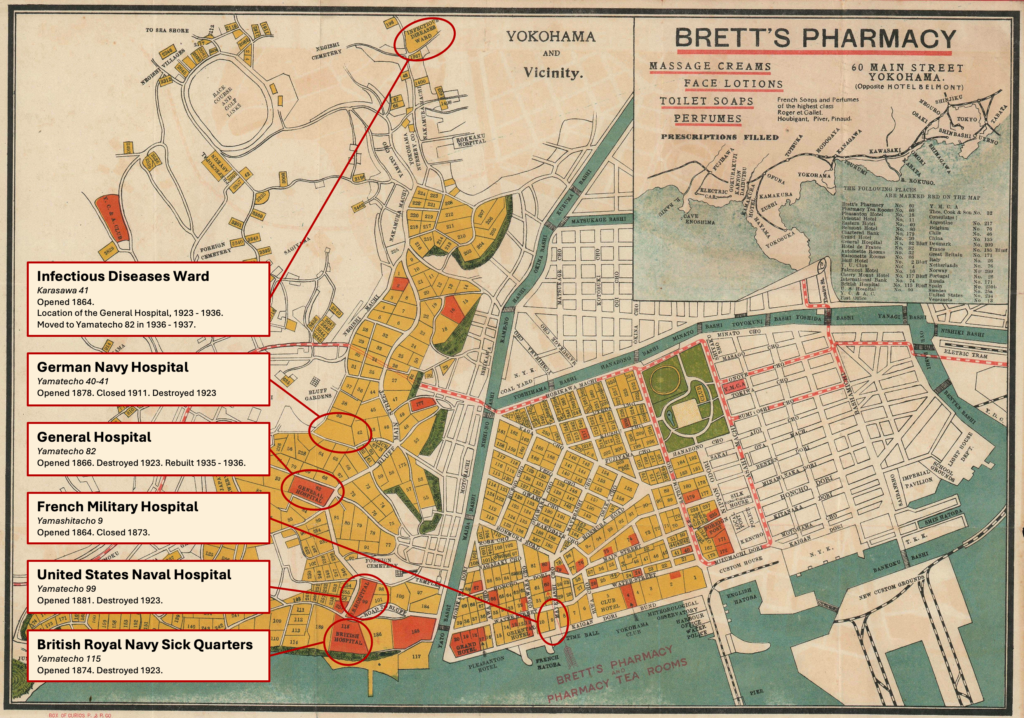
- In the book The Japanese Earthquake (1924) (link), it describes how the foreign community in Kobe supported refugees from the 1923 Great Kanto Earthquake. They took in 3,553 Chinese and 1,743 European refugees, including 132 casualties, of whom 42 were serious. The conditions following the earthquake rendered the chances of saving serious cases exceedingly slight.
- The heroic work of Miss C. Dalton and Miss N. Little, matron and head nurse of the Yokohama General Hospital, must be mentioned. With the assistance of a patient, they rescued three helpless individuals from the collapsing building, stayed with them all night—making frequent moves to avoid the flames—and ultimately succeeded in getting them to Kobe uninjured. For this, they received the decoration of the O.B.E.
- Casualties among doctors in Yokohama were high. Of the five practicing, two were killed, and one sustained a compound fracture. The operating theaters had been rendered unusable, so no surgical treatment was possible until they reached Kobe. Sadly, a number of deaths also occurred at sea during transit.
- Dr. Edwin Wheeler from the General Hospital unfortunately died during the 1923 earthquake:

Born in 1841 in Northern Ireland, Dr. Edwin Wheeler arrived in Japan as a young British naval surgeon in 1869 and became a leading figure in the rapidly growing foreign community of Yokohama. In 1885, he was appointed as Dr. Eldridge’s assistant at the Yokohama General Hospital. Dr. Wheeler was said to have brought 500 babies into the world during his decades of service on the Bluff and earned widespread acclaim as a mentor in the still nascent practice of Western medicine in Japan. Viewing the humorous depictions of Dr. Wheeler and his era on the Bluff, one wonders how he ever found the time to provide the exceptional care for which he was known among his patients, given his active involvement in the broader life of the foreign community, particularly in sports. A standout cricket player at the YCAC, he was also an excellent rugby player and enjoyed racing his yachts at the Yokohama Yacht Club, while attending to his prized racehorses at the Negishi Race Track. He resided at Bluff 97, now the site of “America Yama Park,” overlooking the city. His activities seemed to keep him in great health, and he remained in charge of the Yokohama General Hospital until the fire following the Great Kanto Earthquake tragically took his life in 1923 at the age of 82. On the morning of the earthquake he visited his friend Mr. Tom Abbey. Both were trapped in the fires when trying to escape down Main (or some say Bay) Street. It is said that his assistant Dr. Ishiura had relieved him of his other duties by this time. He also succumbed (link)
- The road on the Bluff near the General Hospital became unrecognizable after the earthquake as seen on these pictures:

“General Hospital,” UHM Library Digital Image Collections, accessed November 4, 2024, https://digital.library.manoa.hawaii.edu/items/show/27054.

“Bluff: General Hospital,” UHM Library Digital Image Collections, accessed November 4, 2024, https://digital.library.manoa.hawaii.edu/items/show/27057.
1935-1937
- The Yokohama General Hospital was rebuilt on its plot on the Bluff at Yamatecho 81-82 and completed in 1936 or 1937. Construction began in 1935, supported by numerous donations from Japan and abroad. The new hospital was a two-story reinforced concrete structure (with a third floor added later), designed by Jay H. Morgan, an American architect who also designed several other notable buildings in Yokohama, including the U.S. Consulate (designed in 1932 and constructed at Yamashitacho 6), the Union Building (completed in 1927, no longer standing, where Morgan had his office), Berrick hall, Yamate 111, Yokohama Christ Church, the entrance gates and gatehouse of the Foreign General Cemetary, and the old Negishi Racetrack stands. Incidentally, Morgan later passed away at the hospital on June 6, 1937. However, he may have died at the temporary location in Karasawa rather than the new hospital he designed, as Wikipedia (link) lists Karasawa as his place of death.
- The infectious diseases ward was also moved to Yamatecho, and the lease of the land in Nakamura-cho is said to have been transferred to “The International School” with the concurrence of the Japanese Authorities as it was still being used for the general benefit of the Foreign Community.
- The Franciscan Sisters of Mary began dispatching nurses, a practice that continued until 1949, when a group of Japanese nurses took over the responsibilities of the nursing department.
- Louis Paul Nipkow, involved in the export of raw silk at Sulzer-Rudolph & Company, became Chairman of the hospital in 1936 after it was rebuilt. Medical activities appear to have resumed at Yamatecho 82 around 1936-1937. Mr. Nipkow held perpetual lease rights for plots 42 and 43 at Yamatecho through his wife’s ancestors, the Russel family (link), and contributed greatly to the post-earthquake reconstruction efforts.
During and after the Second World War
1940
- In 1940, Nipkow sold his plots of land and buildings to Dr. Kenji Tademura, a physician at Juzen Hospital and an advisor to Yokohama General Hospital. Nipkow likely left Japan for Switzerland in 1940. Although he was still listed as chairman on the hospital committee as of July 28, 1941, he had probably already departed. Juzen Hospital was originally established in 1871, renamed in 1874, and relocated to Nogeyama. Over the years, it evolved into what is now the Yokohama Municipal Medical College. (link)
1941
- H. Treichler (also known as John Treichler), a Swiss national and director of the trading company Siber Hegner & Co. in Yokohama, became the new chairman of the hospital committee on December 8, 1941.
- Until December 1941, the hospital committee also included French, American, English members. Things changed on December 8 in 1941 when it as reported that Dr. McSparran the resident doctor of the hospital was taken to a prison in Yokohama. “During his imprisonment in a dark unfurnished cell he had three hemorrhages from duodenal ulcers, but was denied medical attention despite numerous requests. While undergoing questioning he collapsed from internal hemorrhage and was unable to stand or walk without assistance, yet he was handcuffed as usual when returned to his cell.” (link)
- Some time later, hospital chairman Mr. Treichler was tortured for two weeks until he confessed to spying on behalf of the Swiss minister and was subsequently sentenced to several decades of imprisonment (link). Although Switzerland was a neutral country, the Swiss community in Japan dwindled from 236 people in 1939 to 99 people in 1945, largely due to rising xenophobia.
- According to these German papers, the hospital committee consisted of the following men:
- July 28, 1941: 1 Swiss (Louis Paul Nipkow), 2 Americans, 2 English, 2 Germans
- December 8, 1941: 2 Swiss (Mr. Nipkow not on the list), 2 English, 1 American, 2 Germans
- May 25, 1942: 2 Swiss, 1 Italian, 4 Germans
1942
- As of March 1942, the hospital committee was comprised of members from Japanese, German, Italian, Swiss, and Chinese backgrounds.
- According to a German memorandum from 1942 (link), all perpetual lease rights for the two plots on which the hospital was built were converted to freehold property rights effective April 1, 1942.
- On June 5, 1942, the Yokohama General Hospital was designated an enemy asset. However, the hospital was not closed and was placed under the management of Mitsubishi Trust Co., Ltd. (link).
- The imprisoned Dr. McSparran was evacuated in July 1942 after six months of internment aboard the ship MS Gripsholm. The ship, which arrived in Japan carrying Japanese nationals from the United States as part of a negotiated exchange, took Dr. McSparran to New York. He later traveled on to Scotland (link).
1943
- In June, the General Hospital Committee, comprising Europeans from Allied and neutral countries, informed the Japanese Imperial Government (through the Ministry of Foreign Affairs) that they had agreed in principle to a reorganization plan from January 21. At the same time, they established a new committee chaired by Hajime Matsushima, which included six Japanese members and four foreign members.
- On September 15, an application was submitted to the Minister of Health for the establishment of the Yokohama General Hospital Foundation (財國法人横浜一般病院) (link).
1944
- On January 20, the establishment of the “Yokohama General Hospital Foundation” was officially approved. The Ministry of Finance transferred the hospital assets, which had been nationalized as enemy property, to the foundation free of charge. This transfer was officially registered on February 22.
- In March 1944, at the request of the Navy, the Yamate area was designated a prohibited zone for foreigners, and the hospital was rented out to the Yokosuka Naval Hospital. As an alternative, a hospital named “Kanto Hospital” (Kanto Byoin), located in Aioi-cho (Kannai) in Naka-ku and originally founded in 1923, was acquired through mediation by the Navy and Kanagawa Prefecture. This facility was relocated on March 23, and operations began at the new location in Kannai on July 1, with the following departments: Internal Medicine, Surgery, Obstetrics and Gynecology, Radiology(link).
1945
- On May 29, during the Yokohama Air Raid, incendiary bomb attacks devastated the city, reducing it to a vast wasteland. However, the hospitals in Yamate and Kannai were largely spared from destruction.

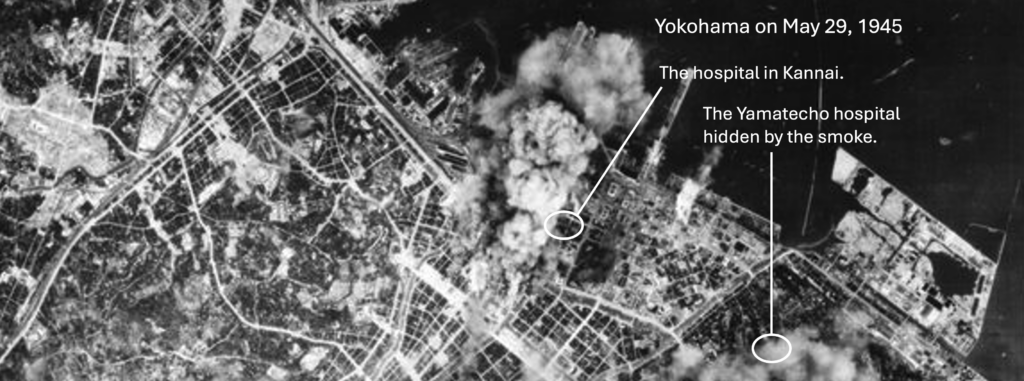
- On August 15, the Pacific War ended. Shortly after, on August 28, Allied forces occupied Japan, and on August 30, General MacArthur arrived at the Hotel New Grand. The hospital building in Yamate was subsequently requisitioned for use by the U.S. military (link).
1946
- After World War II, the hospital in Yamate returned to Western management and resumed its original name, “The Yokohama General Hospital,” on July 1, 1946.

- Meanwhile, the hospital in Kannai came under Japanese management and was renamed the “International Goodwill (Shinzen) Hospital” on July 3, 1946. In 1990, the Kannai hospital was relocated to Izumi-ku (link). A medallion that once adorned the front façade of the Kannai hospital is still on display today here near the entrance of the appropriately named “Lions Stage Kannai Medallion” apartment building, which now occupies the former hospital site.

1948
- The consuls of the United Kingdom, the United States, France, and the Netherlands in Yokohama held a meeting of the community to elect a new international committee to take over the hospital. Mr. P. T. Davis was elected Chairman. Also the management of the nursing department was transfered from the Franciscan Order of Mary to a locally managed alternative. Nurses from the Order continued to be despatched until 1949.
1949
- In 1949, three key individuals were associated with the hospital: Mr. T.P. Davis, serving as the hospital’s chairperson; Dr. Y. Ikeda, recognized as the first Japanese resident doctor; and Matron S. Kawamoto, noted as the hospital’s first Nursing Director at that time (link).
1950
- Due to a revision of the law, the name “General” became restricted to hospitals with at least 100 beds. As a result, Yokomama General Hospital was renamed to “Bluff Hospital”.
Here are some pictures dated after 1950 from the postwar era (pictures from our archives).







1968
- A large bronze plaque, currently stored in the basement of the Bluff Clinic, was originally mounted on the wall to the right of the entrance lobby of the Bluff Hospital following a major expansion. The expansion involved the addition of a new wing. The outpatient clinic that had been in the basement until then was moved to the first floor, and the number of rooms increased on the second and third floor. The ribbon-cutting ceremony for the new facility was performed by Her Imperial Highness Princess Chichibu during the opening ceremony.
- Titled “Roll of Honour,” the plaque listed individuals and organizations who made significant contributions to the hospital, starting with Jenkins in 1863 and concluding with Princess Chichibu in 1968. It originally included 27 individuals and one organization. However, according to Mr. Edwards, a former British consul, the list was later revised after committee discussions to include 26 individuals and one organization (link). More details on the plaque can be found in an article by Dr. Ide, who was the hospital director at the time of the Bluff Hospital’s closure (link).

- Roll of honour plaque. Names and reasons for inclusion (and exclusion):
| Year | Name | Reason for inclusion/exclusion |
|---|---|---|
| 1863 | Dr. Griffith Richard Jenkins | Founder of the Yokohama Public Hospital (the first Western hospital in Yokohama). |
| 1866 | Dr. Arend de Meyer | Founder of the Dutch Hospital on the Bluff. A Dutch naval surgeon. Died at the age of only 36 on August 7, 1869, and was buried in the Foreigners’ Cemetery of Yokohama. (link) |
| 1867 | Alfred John Wilkin | Founder of the Yokohama General Hospital. |
| 1867 | Consul Francis Gerhard Myburgh | Born in South Africa. Dutch interpreter. The British Consul, and Chairman of the first hospital committee who oversaw the transition from the Dutch hospital. Died at the age of 30 in 1868 in Kobe. His name was proposed but for unknown reasons was not included in the final list. |
| 1869 | Consul Herman Ludwig Grauert | Committee Chairman who planned the first large hospital extension |
| 1870 | Dr. James Joseph Robert Dalliston | Surgeon. The first resident physician until he died in 1875. |
| 1876 | Dr. Stuart Eldridge | Arrival in 1871 in Yokohama. Resident doctor from 1876 until his death in 1901 at the age of 58. Held many offices such as the President of the Society for the Advancement of Medical Science in Japan. |
| 1882 | Matron Paunceforte | The first nursing director (“Matron”). Her name was excluded from the plate due to insufficient background information. Married to actor George Paunceforte who managed the “Shakespeare Inn” or “Hotel” in Negishi from 1878 to 1899. The hospital directories of this day did not mention her (but they seldom mentioned nurses). It is said that a daughter also worked at the hospital which is quite likely. |
| 1885 | Dr. Edwin Wheeler | He became assistant doctor in 1885 of Dr. Eldridge, and later became resident. |
| 1893 | Dr. Neil Gordon Munro | Successor of Dr. Eldridge as resident doctor in 1893 or possibly 1892. Lived 1863-1942. He worked with Dr. Wheeler for many years. During this period he became interested in the incidence of tuberculosis among the Ainu in Hokkaido whom he visited regularly and among he eventually settled in 1929. He became a leading authority on their origins and culture and did much for their welfare. He was also an expert in the Arabic, Sanscript and Chinese characters and languages. |
| 1923 | Matron C. Dalton | Matron (nursing director) at the time of the earthquake. Helped many patients escape the fire. |
| 1923 | Nursing Sister N. Little | Head Sister at the time of the earthquake. Helped many patients escape the fire. |
| 1923 | Everet Welles Frazer | Chairman at the time of the earthquake. Lived 1867-1951. Managing director of Sale & Frazar Ltd. |
| 1935 | Ernest Hamilton-Holmes | Came to Japan in 1897, and became Consul-General for Great Britain in Yokohama in 1927. Secured the leasehold rights for reconstruction after the earthquake. |
| 1935 | Fransiscan Sisters of Mary | 5 foreign and 1 Japanese Franciscan Catholic Sisters started working at the hospital. The Franciscan Sisters administered the Hospital as nursing staff until 1949. The first proposal for the plate included Reverend Mother Roberte’s name, but this was later changed to the name of the organization. |
| 1935 | Sister Angela (Enda) Fitzgerald | Chairwoman of the first Ladies Committee. Member of the “Infant Jesus Sisters”. Came to Yokohama in 1919. Earthquake survivor (1923). Spent WW2 in Japan. Worked at Saint Maur school. Lived 1890-1980. |
| 1936 | Louis Paul Nipkow | Chairman of the rebuilt hospital. The medical activities returned in 1936-1937 to the location at Yamatecho 82. He left for Switzerland in 1941. |
| 1937 | Dr. Joseph L. McSparran | First resident physician after the rebuilt hospital. Was evacuated on a negotiated deal in 1942 to Scotland. |
| 1949 | T.P. Davis | Chairman when the hospital was reopened after World War Two, after reopening. |
| 1949 | Dr. Y. Ikeda | First Japanese doctor to be a resident physician. |
| 1949 | Matron S. Kawamoto | First Japanese Matron (nursing director). |
| 1951 | Dr. M. C. Morton | The first Medical Director. |
| 1953 | Mrs. H. J. Knapp | The first Chairwoman of Ladies Committee after the war. |
| 1960 | C. G. Hampden-King | Chairman during the term of exercising freehold land ownership, during the re-construction of the nursing dormitory. |
| 1962 | Dr. L. Kiston | Appointed Full-time Director. |
| 1963 | Mrs. B.K. Denton | Chairman Ladies Committee. |
| 1966 | G. C. Barclay | Chairman who planned the first large scale expansion. |
| 1967 | C. W. Newton | Director Finance of the subcommittee for the expansion project. |
| 1968 | D. A. White | Chairman during the expansion. |
| 1968 | Her Imperial Highness Princess Chichibu | By the request of the British Consul, Her Royal Highness Princess Chichibu, Honorary Patron of the Japan-British Society, became the Honorary Director of the hospital. Princess Chichibu refers to Princess Setsuko, the wife of Prince Chichibu, who was the younger brother of Emperor Showa (Hirohito). She was born in England as her father was a diplomat and politician. |
Closure of the Bluff Hospital and opening of the Bluff Clinic
1981-1987
- The closure of the Bluff Hospital in 1981 marked a significant moment in Yokohama’s history. According to an article from The Japan Times, at the time of its closure, the hospital employed six doctors and 20 nurses. The facility had departments for surgery, internal medicine, obstetrics, and gynecology, reflecting a comprehensive range of medical services for the community.
- Several factors led to its closure of this hospital which was only aimed at foreigners, including the gradual shift of international business from Yokohama to Tokyo, Yokosuka, Chiba and Kimitsu, which resulted in a decline in the foreign resident population and a reduction in seamen visiting the port. Also, the turn around of ships decreased from weeks, to hours. Ship crews changed to third world countries. The aviation industry developed and foreign residents returned to their home countries for long-term treatment. As a result, and due to the rapid increase in labour, administration, and general costs, combined with a high staffing rate, and insufficient compensation rate from the Japanese National Insurance scheme, there were five consecutive years of financial deficits, which ultimately made continued operation unsustainable.
- There followed an unpleasant period which the Labor Union, with support from the Medical Workers’ Cooperative, had to be bargained with and compensated, and the debts were discharged. The original plan was to pledge the land to a construction company who planned to build an apartment complex of 48 units of which 4 would be ours, plus a small clinic tacked on to the end. The developers forwarded us the money to discharge debts. The union eventually agreed to a settlement but could not be completely discharged, and not before they occupied the building for many months. After 10 months of negotiations, a settlement was reached in August 1982 under the mediation of the Kanagawa Labor Relations Commission. The union then vacated the hospital.
- However, opposition from local residents, prevented an agreement even after a year. In 1984, with mediation from the Kanagawa Medical Planning Division, the plan was revised. To raise funds, it was decided to liquidate the real estate, selling 1,253 tsubo of land to Futaba School. The sale was completed in June, and the remaining Bluff Hospital buildings were demolished. Plans were drawn up for the construction of a clinic on the remaining 200 stubos, this being formulated in September 1984 and finalized into the idea of having a 70 tsubo two story building, the lower floor to be the clinic, and the second floor for the doctor’s apartment with a cellar for utilities and storage. The building was designed by a Swiss architect of Kaiser Associates, and built by Tatsumura Gumi. The building is made of reinforced concrete, and is designed to require minimal maintenance, and withstand an earthquake of up to 7.2 on the Japanese scale.

- The ground breaking ceremony was held in May 1985 and the building completed and handed over on the January 22, 1986.
- An opening ceremony was held on March 21, 1986, and in May a British physician was appointed, marking the clinic’s opening.
- Within six months after the English physician started working at the Bluff Clinic in 1986, complaints arose among the foreign residents that the physician was unsuitable. Additionally, the number of patients, limited to foreigners, continued to decline. As a result, the board terminated the employment contract with the physician in December of the same year.
- The board discussed with representatives of the foreign resident community whether the next physician should also be recruited from the United Kingdom. Based on their feedback, it was decided to hire a Japanese physician proficient in English. At the same time, the clinic began offering treatment under the Japanese public health insurance system. Dr. Tsunehiro Akashi, was appointed, and the clinic reopened in July 1987.

2000
- On September 18, 2000, John Willcox attended his last Bluff Clinic committee meeting. As the Chairman, he had been responsible for the fund-raising for and the building of the Bluff Clinic that we know today. For his fine achievement, John was awarded the MBE by Her Majesty the Queen.
2005
- On April 1, 2005, the Bluff Clinic opened a dental department with two dental chairs. We changed our name to “The Bluff Medical and Dental Clinic.”

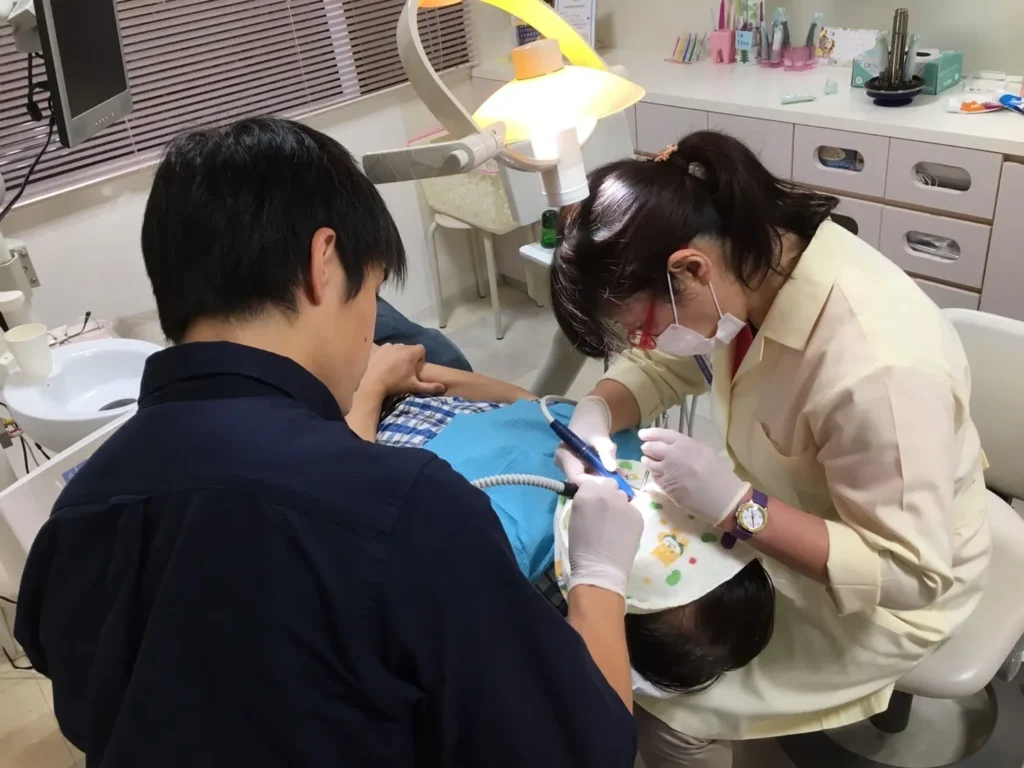
A talk by John Wilcox, who served as Chairman when the new Bluff Clinic was inaugurated in 1986, is preserved in our archives.
The original text of the speech by John Willcox can be read by clicking here.
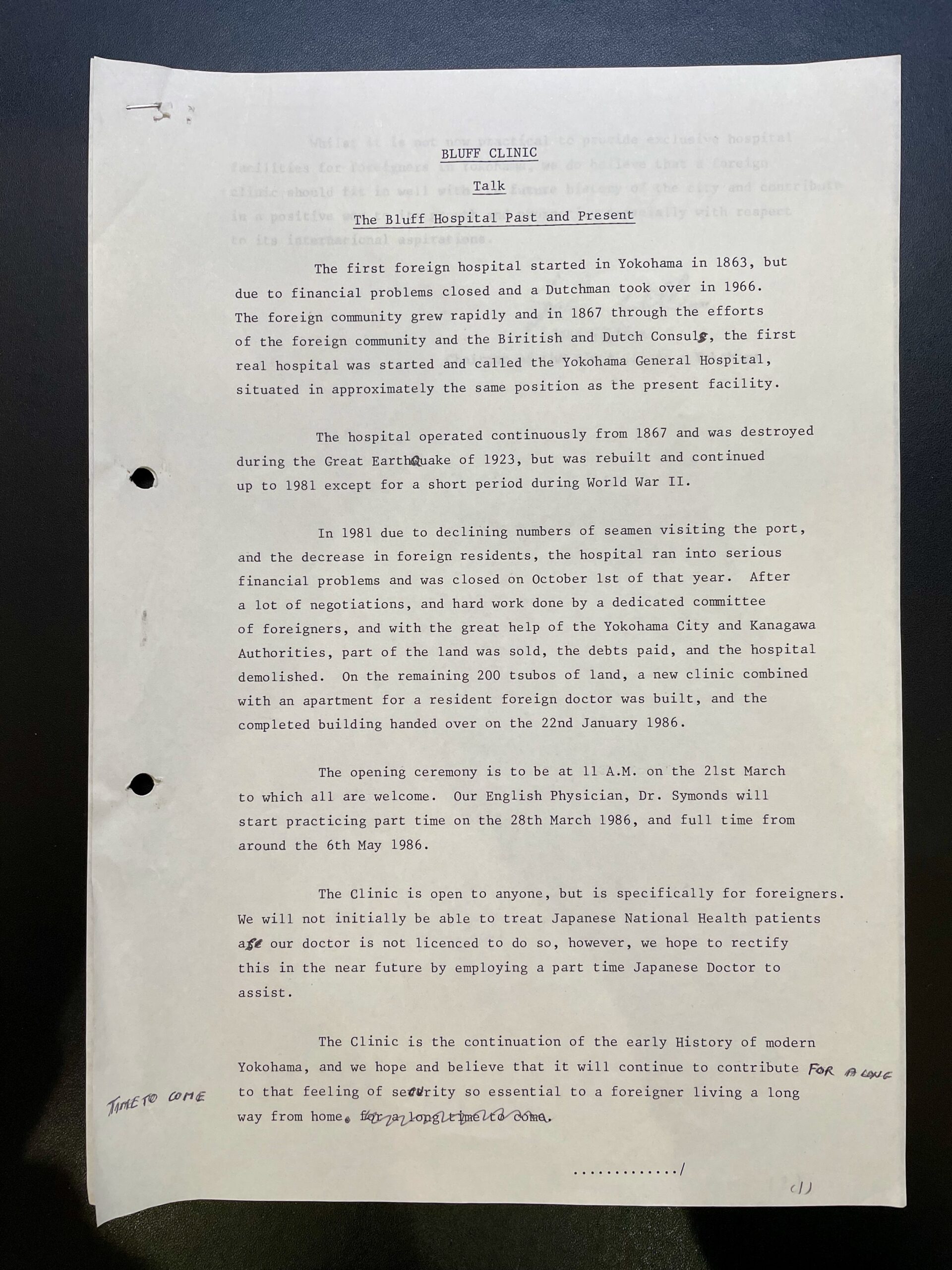

Article from 1981 in the Japan Times Newspaper (from our archives):

Article from The Asahi Shimbun after the Bluff Clinic opened in 1986 (from our archives):


For further reading. Click here to read a historical paper in from our archives from 1969 written by Consul Malcolm Edwards, titled “The Yokohama Public Hospital, The Bluff (Dutch Hospital), The Yokohama General Hospital, The Bluff Hospital (1963-1963)”
